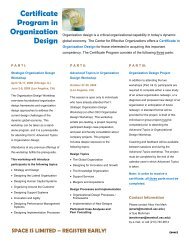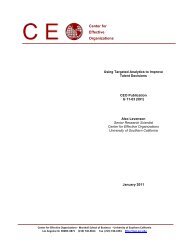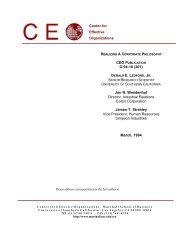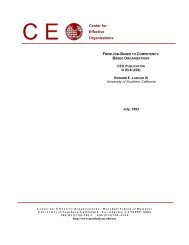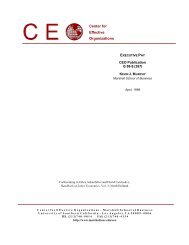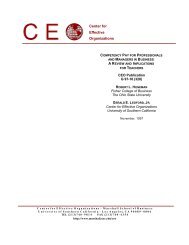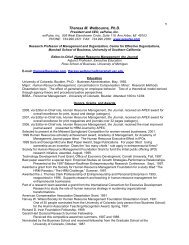Our Past, Present, and Future in Teams - Center for Effective ...
Our Past, Present, and Future in Teams - Center for Effective ...
Our Past, Present, and Future in Teams - Center for Effective ...
You also want an ePaper? Increase the reach of your titles
YUMPU automatically turns print PDFs into web optimized ePapers that Google loves.
6The first set of assumptions that must be exam<strong>in</strong>ed perta<strong>in</strong> to motivation. <strong>Our</strong> national culture helps todeterm<strong>in</strong>e what motivates us. For example, some cultures can be classified as <strong>in</strong>dividualistic, or cultures <strong>in</strong> whichpeople tend to value their own self-<strong>in</strong>terest <strong>and</strong> welfare over the <strong>in</strong>terests of groups or societies; other cultures areknown as collectivistic, or cultures <strong>in</strong> which people tend to value the welfare of groups more than their own welfare(Hofstede, 1980). Individualists are motivated by the opportunity to ga<strong>in</strong> personal recognition. They resist work<strong>in</strong>g<strong>in</strong> teams more than people from collectivistic cultures (Kirkman, 1996; Kirkman & Shapiro, 1997). Such resistancelowers team effectiveness on outcomes such as productivity, job satisfaction, cooperativeness, <strong>and</strong> organizationalcommitment (Kirkman, 1996). It will take time <strong>and</strong> experience <strong>for</strong> people to adjust their notions of fairness <strong>and</strong> equityto <strong>in</strong>clude collective accountability. Tak<strong>in</strong>g a longer term focus <strong>and</strong> underst<strong>and</strong><strong>in</strong>g the eventual payoffs <strong>for</strong> early<strong>in</strong>vestments <strong>in</strong> team-based systems is essential <strong>for</strong> harness<strong>in</strong>g the motivational power of teams.In underst<strong>and</strong><strong>in</strong>g motivational assumptions, it is also important to consider expectations. Research atteststo the importance of collective expectations <strong>in</strong> determ<strong>in</strong><strong>in</strong>g our level of motivation, <strong>and</strong> subsequently ourper<strong>for</strong>mance (B<strong>and</strong>ura, 1997; Gibson, 1995). When we believe we can accomplish objectives as a team, we aremotivated to stick with our work tasks <strong>and</strong> prevail. However, sometimes these high expectations get out of h<strong>and</strong>, tothe po<strong>in</strong>t that teams hold unrealistic expectations. Cohesive teams often fall prey to this phenomenon, which isreferred to as “groupth<strong>in</strong>k” (Janis, 1982). Co<strong>in</strong>cid<strong>in</strong>g with extremely high expectations, teams suffer<strong>in</strong>g fromgroupth<strong>in</strong>k also hold illusions of <strong>in</strong>vulnerability. Such teams ignore important external <strong>in</strong><strong>for</strong>mation sources whichmight help them adjust their per<strong>for</strong>mance to better fit the needs of customers. Individualistic teams appear to beparticularly susceptible to over confidence (Gibson, 1996). This may be because <strong>in</strong>dividualists view their team as anentity <strong>in</strong> <strong>and</strong> of itself, rather than connected to the external context, <strong>and</strong> are there<strong>for</strong>e even less apt to utilize externalsources of <strong>in</strong><strong>for</strong>mation to make corrections <strong>in</strong> their behavior <strong>and</strong> improve their per<strong>for</strong>mance. Particularly <strong>in</strong><strong>in</strong>dividualistic cultures, team-based organizations need to have systems that help teams set realistic expectations.This allows teams to stay motivated, while at the same time open to learn<strong>in</strong>g from feedback <strong>and</strong> mistakes.Work StructureBeyond motivation, a second doma<strong>in</strong> of assumptions concerns the structure of work. Traditional workgroups were generally <strong>for</strong>med around common technical or functional skills <strong>and</strong> areas of expertise (<strong>for</strong> example,account<strong>in</strong>g, f<strong>in</strong>ance, or production). In recent years, it has become apparent that organiz<strong>in</strong>g work around a process



